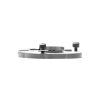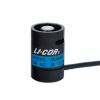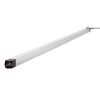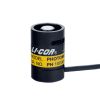LI-COR LI-200R Solar Radiation Sensors
Features
- Weather resistant and durable in long-term outdoor deployments
- Cosine corrected to 82° incident angles for accurate measurements
- Detachable sensor simplifies installation and removal of sensor
- Free ground shipping
- Expedited repair and warranty service
- Lifetime technical support
- More
Overview
The LI-COR LI‑200R measures total solar radiation with an unfiltered silicon photodiode. Although the LI‑200R does not measure the total solar spectrum, its measurements correspond closely to first-class thermopiles under outdoor conditions.
Mechanics
The crown of the sensor rapidly sheds water, reducing pooling around the sensor. It also physically blocks light that is outside the hemisphere of sensitivity, providing a precise cosine response.
Applications
Ideal for agricultural, meteorological, solar energy, and environmental research, it is available with a variety of cable lengths and output signals for compatibility with most data loggers.
- Absolute Calibration: Calibrated against an Eppley Precision Spectral Pyranometer (PSP) under natural daylight conditions. Absolute uncertainty under these conditions is ±3% typical; ±5% maximum.
- Sensitivity: Typically 90 μA per 1,000 W m-2
- Linearity: Maximum deviation of 1% up to 3,000 W m-2
- Response Time: Less than 1μs (2 m cable terminated into a 147 Ohm load)
- Temperature Dependence: ± 0.15% per °C maximum
- Cosine Correction: Cosine corrected up to 82° angle of incidence
- Azimuth: < ± 1% error over 360° at 45° elevation
- Tilt: No error induced from orientation
- Detector: High stability silicon photovoltaic detector (blue enhanced)
- Sensor Housing: Weatherproof anodized aluminum body with acrylic diffuser and stainless steel hardware; O-ring seal on the sensor base
- Size: 2.36 cm diameter × 3.63 cm (0.93” × 1.43”)
- Weight: 24 g head; 60 g base and cable (2 m) with screws
- Cable Length: 2 m, 5 m, 15 m, 50 m (6.5’, 16.4’, 49.2’, 164’)
In The News
Thin Ice: Monitoring Winter Lake Dynamics at Mohonk Lake
Historically, water quality monitoring during the winter has been difficult and often avoided altogether—however, monitoring throughout the year can highlight the influence of various environmental stressors and track the changes systems undergo during the winter. In particular, long-term monitoring efforts in systems like Mohonk Lake can underline the effects of climate change and acid rain. David Richardson, a professor of biology at the State University of New York (SUNY) at New Paltz , spends his time outside of the classroom monitoring the nearby watersheds. After getting his engineering undergraduate degree, Richardson realized he wasn't interested in the typical job offerings and applied to an ecological science graduate program at the University of Maryland.
Read MoreWith A Modular Update, LI-COR Terrestrial Light Sensors Shine
For environmental professionals looking to measure light, the sun’s energy or photosynthetically active radiation, there is no better choice than LI-COR’s all-new line of terrestrial light sensors. The series, including the LI-190R, LI-200R and LI-210R, has been redesigned from the ground up and is more convenient, reliable and durable than ever before. The new design centers on a modular setup that lets users detach the sensor head from the base. This makes it possible to swap out sensor heads for calibration or to measure different light parameters. In addition, it adds to project flexibility, saving users time and money.
Read MoreLong-Term Monitoring in the Chautauqua Lake Watershed
With a widely developed shoreline, Chautauqua Lake experiences influxes of non-point source pollution that have historically impacted the health of the lake. The Chautauqua Lake Association (CLA) has been monitoring the lake for over two decades, reporting on changes that have occurred over the years. A pair of local lake advocates, Jane and Doug Conroe, have lived on the lake for over 40 years and have played an important role in establishing monitoring programs and facilitating consistent data collection throughout the watershed. Doug has been involved with the Chautauqua Lake Association (CLA) since the pair moved to the area in 1980, and is currently serving as the Executive Director.
Read More

































